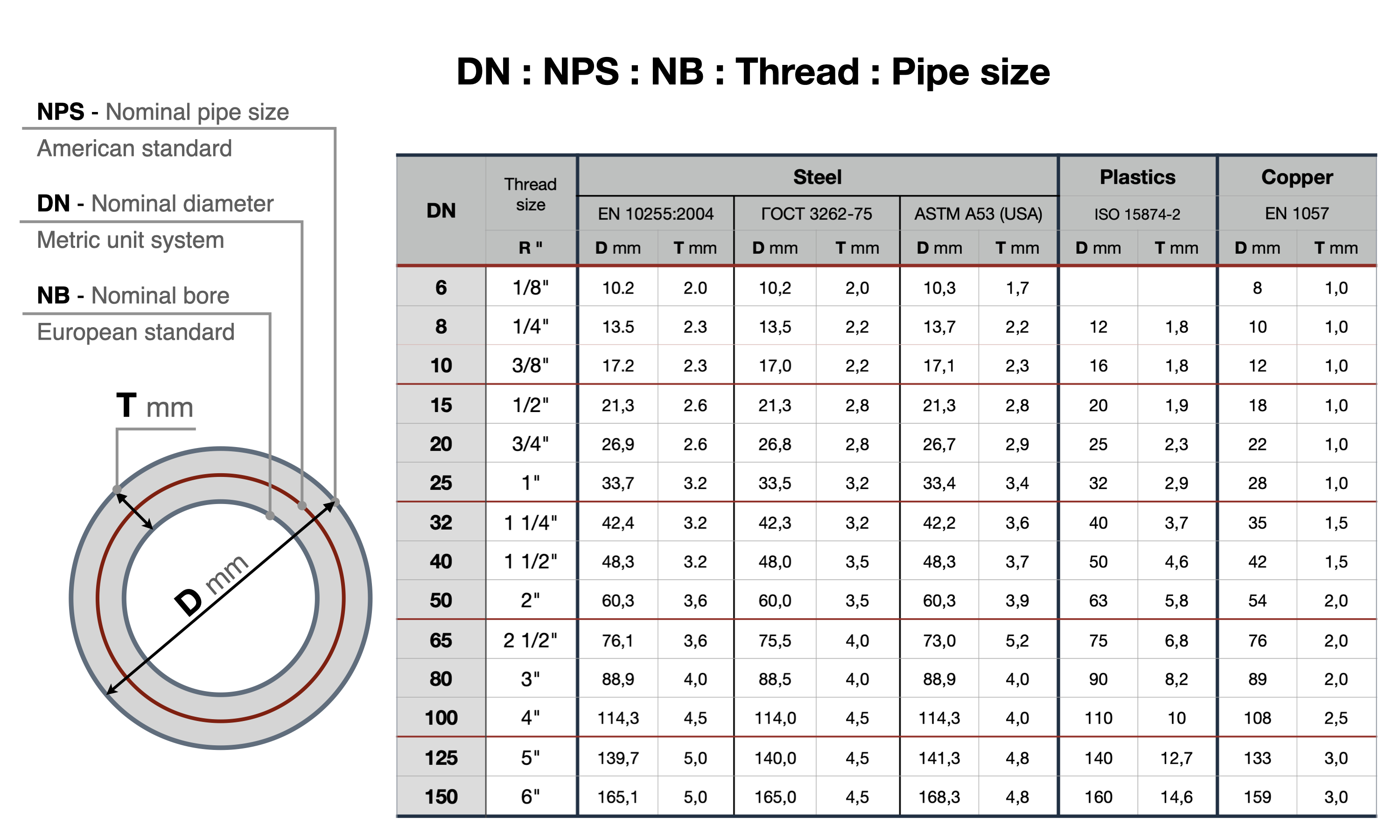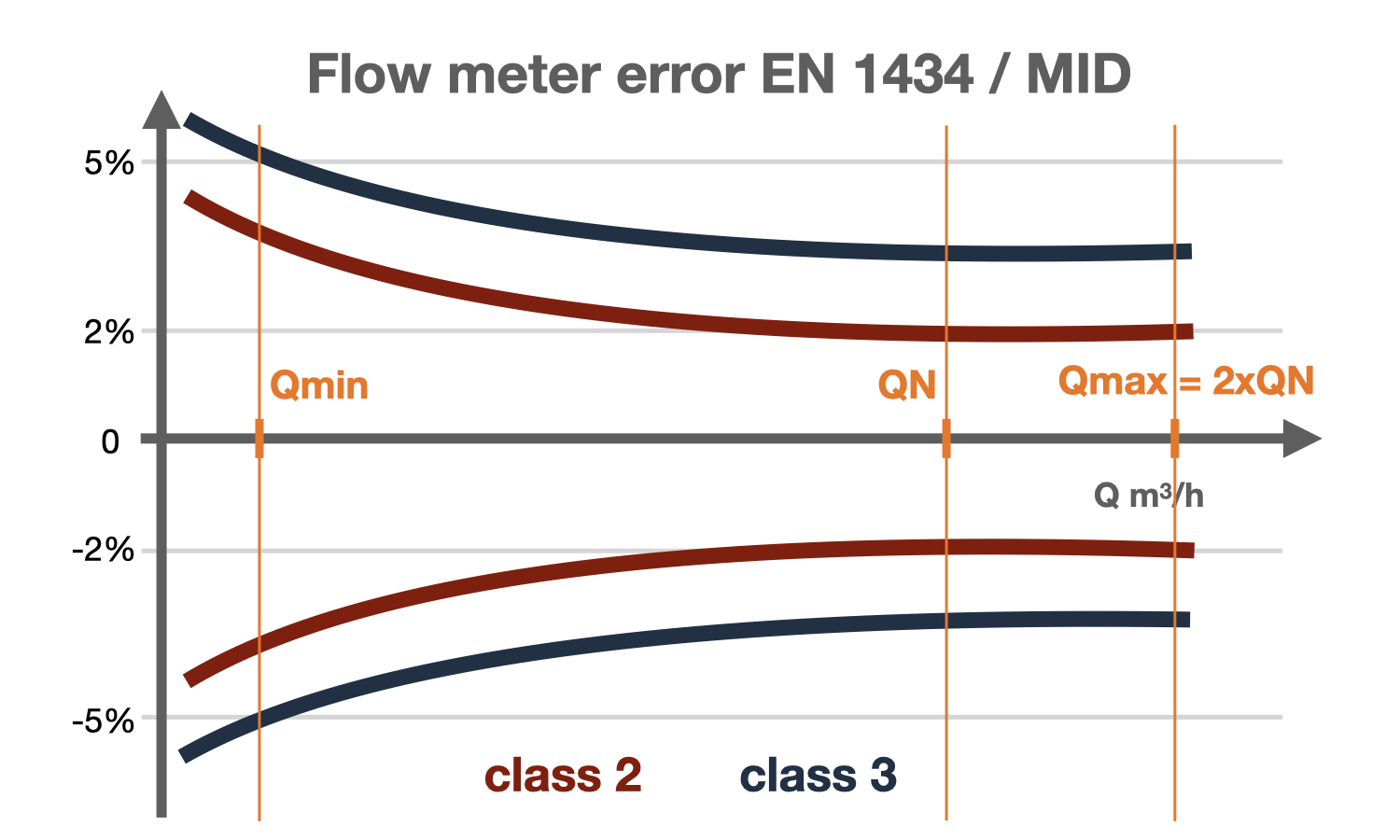Please do not block ads on our site. Clicks on ads help us exist, grow and become more useful for you!
Technical specifications of heat meters
DN of heat meter - nominal diameter of the opening in the connecting pipes. The DN value is used to standardize the types and sizes of pipeline fittings. The actual diameter of the opening may differ slightly from the nominal diameter.
In heat meters with threaded connections to the pipeline, the actual diameter of the fittings is one nominal size larger than the DN specified in the heat meter passport. This is because threaded meters are used with connecting nuts that are threaded to a larger nominal size than the reverse side of the nipple with an external thread that is connected to the pipeline.
PN of heat meter - nominal pressure - the maximum pressure of the working medium at a temperature of 20°C, at which the heat meter can operate for a long time and safely.
Permissible Flow Ranges
Qmax (qs) maximum flow rate - the highest flow rate at which the heat meter can operate for a short time (less than 1 hour per day and less than 200 hours per year) without exceeding its maximum permissible error.
QN (qp) nominal flow rate (continuous flow) - the highest flow rate at which the heat meter can operate for a long time without exceeding its maximum permissible error.
Qmin (qi) minimum flow rate - the smallest flow rate at which the heat meter can operate with an error corresponding to the declared accuracy class.
Dynamic range - the ratio of QN/Qmin, according to European standards, should correspond to the following values: 10, 25, 50, 100, or 250.
Permissible temperature limits
Maximum permissible temperature - the maximum temperature of the heat transfer fluid at which the heat meter can operate without significant malfunctions, provided that the maximum permissible working pressure and nominal flow rate are not exceeded for short periods of time (less than 200 hours per year during the entire service life).
Tmax maximum temperature - the highest temperature of the heat transfer fluid at which the heat meter operates and its error remains within the allowable error limits.
Tmin minimum temperature - the lowest temperature of the heat transfer fluid at which the heat meter operates and its error remains within the allowable error limits.
dTmax maximum temperature difference - the maximum temperature difference at which the heat meter can operate at a heat flow rate not exceeding the maximum value and its error remains within the allowable error limits.
dTmin minimum temperature difference - the minimum temperature difference at which the heat meter can operate and its error remains within the allowable error limits.
Accuracy classes
The limits of the permissible relative error of the heat meter (when calculating the amount of heat) according to EN 1434-1, depending on the temperature difference, must not exceed the values given in the table.
Note: the error values corresponding to the flow rate in the range from Qmin to Qt are given in parentheses.
| Temperature Difference °C |
Class 2 | Class 2.5 | Class 4 | Class 5 |
|---|---|---|---|---|
| dTmin < dT < 10 10 < dT < 20 20 < dT < dTmax |
+/-4% +/-3% +/-2% |
+/-5,5%(+/-7,5%) +/-3,5%(+/-5,5%) +/-2,5%(+/-4,5%) |
+/-6%(+/-8%) +/-5%(+/-7%) +/-4%(+/-6%) |
+/-8%(+/-10%) +/-7%(+/-9%) +/-5%(+/-7%) |
Permissible error limits for flow meters (when calculating flow rate) according to EN 1434-1:
Class 1 — E=+/-(1 + 0.01 QN/Q), but not more than +/-5%.
Note: The formula presents an assumed value of permissible error. The value of permissible error for flow meters of the first class will be determined when testing methods for flow meters are improved.
Class 2 — E=+/-(2 + 0.02 QN/Q), but not more than +/-5%
Class 3 — E=+/-(3 + 0.05 QN/Q), but not more than +/-5%
where Q is the actual flow rate of the heat transfer medium.
question : comment : feedback
370
 Catalog of
Catalog of compact heat meters
Gross
Landis Gyr
Landis Gyr
Zenner
Engelmann
Engelmann
DIEHL
Kamstrup
Sensus
Sontex
Sontex
Sontex
Itron
Itron
Apator
Maddalena
Landis Gyr
Kamstrup
Sontex
DIEHL
Sensus
Engelmann
Apator
Itron
Maddalena










 EN 1092-1
EN 1092-1
